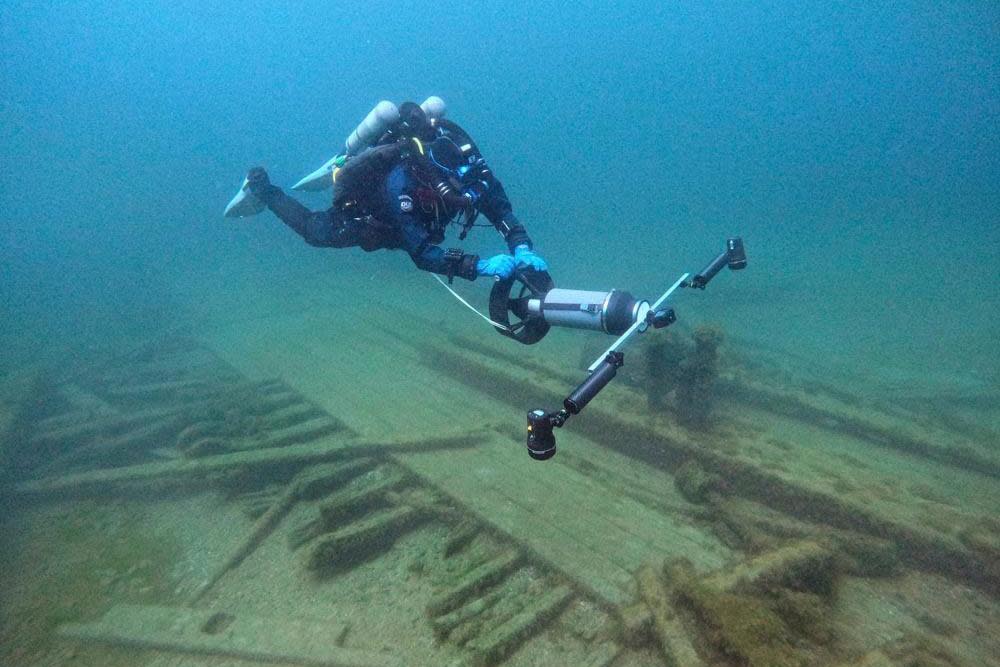Wreckage of schooner that sank in 1893 found in Lake Michigan

Shipwreck hunters with the Wisconsin Underwater Archaeology Association have discovered the wreckage of a schooner that sank in Lake Michigan 131 years ago.
A team of marine archaeologists located the Margaret A Muir – a 130ft, three-masted schooner built in 1872 – in 50ft-deep waters off the coast of Algoma, Wisconsin, on 12 May.
The association is now working to nominate the site for the National Register of Historic Places, where it would join the schooner Trinidad, which the team located in deep water off Algoma in June last year. Altogether, the Great Lakes are believed to hold the remains of more than 6,000 ships going back to the 17th century, when the region was a major shipping area with access to the Atlantic Ocean via the St Lawrence Seaway. Wisconsin’s portion of the lakes are estimated to be home to about 780 shipwrecks, of which 250 have been identified.
“The reason we look for these wrecks is we want to share them with the communities of Wisconsin because these are some of the last tangible hooks that these communities have to their maritime history,” Brendon Baillod, WUAA president, told CNN Travel.
Baillod and colleagues Robert Jaeck and Kevin Cullen discovered the Muir after only a day of searching. Baillod had already narrowed the search grid to about 5 sq miles using historical records. He and teammates used sonar equipment to go over the area and found the wreck during their final pass of the day.
It was “around 4 o’clock. And as we’re pulling up the sonar, the darn wreck crawls across the screen. We caught her in the last 30 seconds that we could have,” Baillod said.
The team have since collected hundreds of high-resolution images, which were then used to create a 3D photogrammetry model of the site, now posted on YouTube. Photos show that the ship’s deck collapsed, and its sides have fallen outward. Although it was in shallow fishing waters, the ship went undetected because it had settled into a crater.
“One of the things that’s important about this wreck is that it’s opened up – we call it ‘filet of schooner’ – where the deck came off and then the sides opened up. And we can see the architectural construction details of how a 19th-century Great Lakes wooden vessel, a schooner, was built,” Baillod said.
According to the association, despite the deck collapsing, all the deck gear remains – including two giant anchors, hand pumps, its bow windlass and its capstan.
The Muir was built in 1872 by the Hanson & Scove shipyard in Manitowoc, Wisconsin, for Capt David Muir, who named the schooner after his daughter. In 1893, Capt David Clow bought co-ownership of the Muir, and was captaining the ship on 30 September when it sank during a morning storm while en route to South Chicago, Illinois, with a cargo of bulk salt.
The ship had just cleared the narrow Straits of Mackinac when it encountered 50mpg winds. Clow “immediately ordered the crew to abandon ship. No sooner than the order was given, the ship lurched violently and plunged for the bottom, taking Clow’s faithful dog and ship’s mascot with it”, according to the association’s release. The crew of six safely escaped to shore aboard a lifeboat, before the ship sank to the bottom of Lake Michigan.
Clow and his crew battered the storm in a small boat until reaching a beach in Wisconsin, freezing and soaked. Local people from the town of Algoma, where the shipwreck was found, took the men to the nearby St Charles hotel for refuge.
Clow quit sailing after the incident, and said: “I have quit sailing, for water no longer seems to have any liking for me.”


